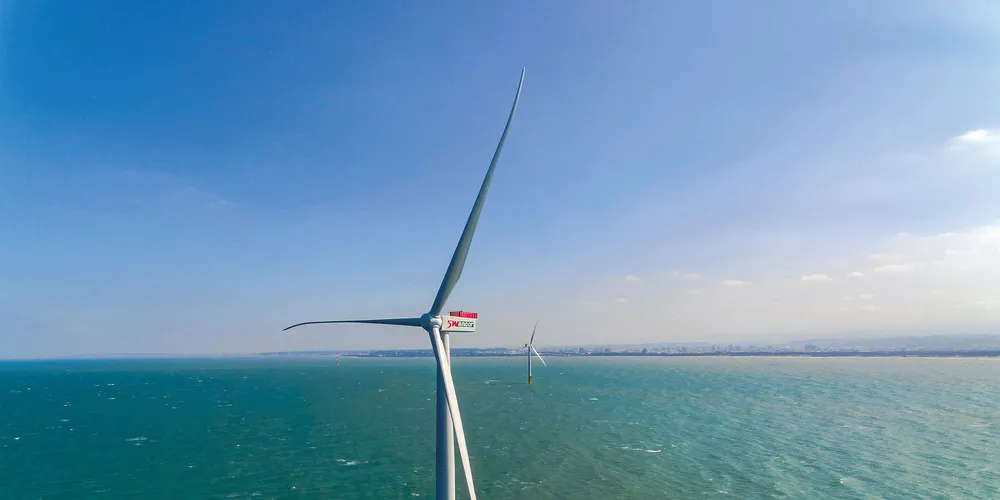Asia's offshore push heralds era of 'typhoon-proof' turbine
ANALYSIS | OEMs are adapting their turbines for the extreme conditions found in Asian waters, writes Darius Snieckus

As offshore wind developers begin to wade out off Asia, “typhoon-proof” has rapidly entered Western OEMs’ lexicon. And with good reason: gales regularly blow through the region at speeds of more than 118km/h — and a super storm can bring gusts of over 300km/h — beyond the engineered limits of a conventional turbine design.
The machines installed off China, Taiwan, Japan, Korea and the area’s other prospective markets will need to be battle-ready and Siemens Gamesa Renewable Energy (SGRE), MHI Vestas and GE Renewables have all already announced that “T” – ie, typhoon — class versions of their machines are on the way.
SGRE’s T-Class SG 8.0-167 DD will be ready for 2020 as will MHI Vestas 9MW model V164, while GE has erected a prototype of a 4.2MW model at the National Renewable Energy Laboratory in the Netherlands for testing.
“We have made multiple regionally-specific adaptions to our 8MW model – and we [are] basing these alterations on experience with our G4 [geared 4MW] turbines at Formosa [wind pilot project off Taiwan],” says SGRE project manager Christian Vestergaard. “This has given us a lot of data on the weather and environmental conditions that our larger turbines will face, including the 20 6MW DD [direct-drive] turbines for the extension.
“But ultimately, we are starting from a very high standard with our ‘European’ model since we have engineering our turbines for the northern seas and very high wind speeds.”
The two Formosa turbines, Vestergaard notes, rode out a typhoon in July 2017 where the strongest gusts were over 40 metres per second and fed back “huge volumes” of data, which “revealed not only how the turbine handles the issue of heavy winds but also the rapid changes of wind direction during the typhoon”.
SGRE has opted to add structural reinforcement of the balsam-wood webs of the 81.5-metre blade used on the T-class 8MW, but that the profile and shell materials used in the design would remain the same for operation in “extreme wind speeds” and so too the transmission system.
Blade-maker LM Wind Power — acquired by GE in 2017 — has been supplying technology into Asia since 2001, including its 75.1-metre model to Goldwind for the Chinese OEM’s 6.7MW turbine, and, most recently, 66-metre units to be flown by Shanghai Electric’s 4.0MW-136. LM’s vice-president of engineering, Hanif Mashal, says its current development work is focused on “future-proofing” its typhoon-proof blades.
The company has tailored its Asian offshore models using high-performance ‘H Glass’ glass-fibre blades, with reinforced balsam and PET (polyethylene terephthalate] both being explored for the design’s inner webs, and more weight-saving PET in the shell.
But, notes Mashal, the technique of “pre-bending” – where the blade is flexed on a bowing machine – is key to allow for “give” during the heaviest wind speeds. “This environment is a good challenge for our engineers,” he says.
Vestergaard underlines that the European offshore pedigree of SGRE’s largest turbines means that the T-Class models will be up to the task off Asia. “In the end, a typhoon in Asia is ‘simply’ a hurricane in America or a cyclone in Australia. Similar weather incident, different name.”
Albert Winnemuller, Head of Technical Contracting at the Japanese-Danish OEM, says that Asian offshore streams being “higher than typically seen for the standard heavy wind conditions that a wind turbine would be designed for [off Europe] ... had to be carefully taken into account”.
“The MHI Vestas development process, design and verification are closely linked,” he stated. “As an example, the rotor blades of the wind turbine will be tested according to the expected and calculated loads [in extreme winds] for the application of the wind turbine. This testing will be for lifetime loading as well as for extreme loading.”
Winnemuller also highlights the increased seismic activity that had to be factored into engineering turbines for offshore Asia, not least in Taiwan which sits atop the so-called ‘Pacific Ring of Fire’.
“Where there is high-seismic activity in the region, extra considerations in the siting process and in the design process for the foundations and wind turbines [will be considered],” he noted.
Floating wind farms, Winnemuller added, could be part of the longer-term solution as they can be “made [to be] suited for typhoon prone areas ... especially at deeper water locations”.
(Copyright)